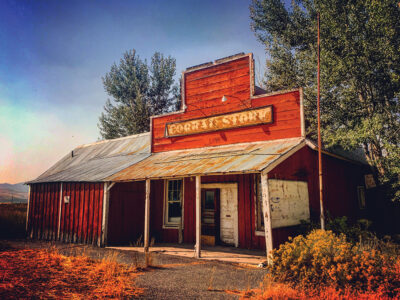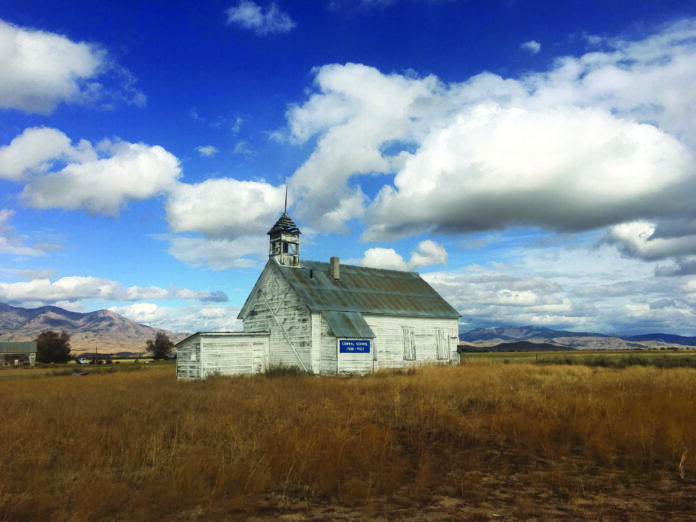By Karen Crowson

If one were to blink, one might miss Corral, a small community nestled along Highway 20, west of Fairfield, on the Camas Prairie. The old Corral Store still stands, serving as a reminder that life existed within this community as well as the homes, barns, outhouses, grain elevators, and the schoolhouse that still stand today.
Corral was settled in 1886. In William McCarter’s book, entitled, “My Early Years: Essays by an Idaho Cowboy,” McCarter explains the origins of Corral’s name, writing, “Corral got its name from the creek, which was named by Hutchins and Moore of the Muleshoe. I don’t know just when they started in the cow business, but it was probably in the later ’70s (1870s). They had a camp on the creek about a half-mile south of where the highway crosses at the present time. This is a school section, which Lloyd Barron has now. They built a house and a lot of good corrals and had about half of it fenced to hold the cattle in while they were gathering. When they would get what they wanted cut out of the roundup, the boss would have the boys take them to the Corral Creek pasture, and that is how the creek got its name.”
McCarter’s father, H.F. McCarter, purchased Robert L. Hicks’ property on Corral Creek on November 30, 1886, and William McCarter was born at Corral on November 11, 1887.
McCarter lists some of the first settlers in Corral, writing, “On Corral Creek, the settlers were (starting at the upper end on the west fork) the three Carter boys, the Wilsons and the Jonases. Tom Carter was the farthest up the creek. He was a carpenter and built several of the first settlers’ houses. He was killed from being thrown from a wagon loaded with lumber that he was hauling from Mountain Home to finish the Trader house. Tom hadn’t proved upon his homestead, so Teen Harness took over his place.”
In 1885, Edward Burnet and his wife Harriet, with their domestic servant Mary Smith, from Alaska, settled in Corral. Burnet was a Civil War veteran, having served as a private in Company K of the 40th Iowa Infantry as well as serving in Kimball’s Division of the 16th Corps during the siege of Vicksburg. Burnet was also in the battle at Jenkins Ferry in Arkansas and had even been stationed at Fort Gibson in the Cherokee Nation. It was after the war that Burnet went on to teach and later become a pharmacist.
After Burnet’s arrival at Corral in 1885, he served one term in the Idaho House of Representatives from 1886-1887 and in 1894 he was defeated in a race for the Idaho Senate in Logan County.
Burnet left Corral in 1901, moving to Boise, where he lived out the remainder of his years as the adjutant and druggist for the Soldiers Home.
In 1891, the first schoolhouse was erected in Corral but was later demolished upon the construction of two new schools in 1908.
McCarter wrote about these early days, including, “My first teacher at the Corral Creek School was Miss Helen Daugherty and my second was John May. This was a summer school. The next, I believe, was Clay Waldren. The pupils were Joe Babington; Pearl and Edith Combs; Ollie, Sal, Siddie, and Clarence Hedden; Manda and Della Kromeri; Jim, Dave and George McGoan; our own clan—Orla, Sallie, and myself; Arthur, Ethel, Ida, Victor, and Harry Hicks; and Frank and Minnie Wondershack.”
McCarter explained school was only held from December through February, writing, “We also had interchange with the Chimney Creek district. Any of the Chimney Creek kids could come to the Corral Creek School in the winter, and the Corral Creek kids could go to the Chimney Creek School in the summer.”
By 1900, the Bell Telephone Company installed a line from Hailey to Boise, passing through the Camas Prairie. McCarter wrote, “The people up to that time had to get a doctor from Hailey. Someone would have to ride to Hailey and the doctor would drive out with a team and buggy. The round trip would take 12-14 hours to Corral.”
With the installation of the telephone, Corral continued to grow.
McCarter wrote, “…along came a salesman who wanted to establish a creamery at Corral. They put up a nice little building and he made a go of it. The old-timers were the main subscribers. In the deal, the salesman would send a butter maker and the subscriber was to pay him 100 dollars a month. So everything worked out very well. The fellow they sent was a good butter maker, but the trouble was getting it to market with a team and wagon in hot weather. The fellow they got the next year was just out of college and didn’t turn out very well, so they closed it down. The building stood there for a year or two and was moved to Soldier and didn’t have much better success there.”
By the spring of 1904, McCarter left Corral, writing once more on the teachers Andy Carson, Mrs. Chester from Atlanta, Miss Harnet, Mr. Dewitt Higgs, and Bessie Laird from Nebraska, writing, (about Laird), “She had been a neighbor of Jesse Carey who had bought the Hot Springs place. She was a very good teacher and would have probably got me through the eighth grade, but I left school and home and went with some other guys out to Mountain Home to seek a job.”
The group of men with McCarter were Clarence Hedden, Dee Miller, Cliff Carpenter, and Fred Koontz, all seeking employment lambing with sheepmen. By 1905, Corral consisted of a store and post office.
McCarter wrote, “…a saloon and feed barn owned by H.L. Clark. Finch also put up a hotel and feed barn. Harrison and Hale bought Clark out and rented the saloon to Cap Homer. Joe Jones put in a good line of groceries and also some farm machinery and a hotel. In about a year, Clark put up another store across the street and Cas Arnold another saloon.”
In 1911, the railroad arrived and McCarter describes this as being hard on the towns, writing, “Soldier and Corral were both missed by over a mile. Corral struggled along for a couple of years or so with the post office and a pool hall. Harrison and Hall had gone broke and left. Clark had become an alcoholic and didn’t live long. Cas Arnold moved his building to Hill City. Cap Homer also moved to Hill City. Joe Jones was shot to death by Ben Higgs in Soldier.”
By 1968, Robert and Mamie Ertter purchased the Corral Store. Nicknamed the Prairie Captain, Robert Ertter was a captain of a barge on San Francisco Bay and would leave his home in Corral every other week to haul crude oil.
During the Ertters’ ownership of the Corral Store there were signs along Highway 20 exclaiming, ‘It’s Coffee Time!’ before approaching the store.
Diane Keever, granddaughter of Robert and Mamie Ertter, was raised by her grandparents, living at the Corral Store from 1970-1990. Keever says she helped operate the store every day after school, on weekends, and every summer. “I think our population was 38 people,” said Keever.
In 2001, the Corral Store closed its doors but still stands today, its aged red exterior still attracting traveling eyes on Highway 20.
If one were to blink, one might miss Corral.



